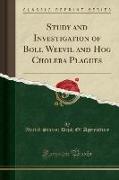Study and Investigation of Boll Weevil and Hog Cholera Plagues (Classic Reprint)
BücherAngebote / Angebote:
Excerpt from Study and Investigation of Boll Weevil and Hog Cholera Plagues
While the work incident to carrying out the intent of the act was distributed among several of the divisions of the bureau, the branches now known as Farmer's Cooperative Demonstration Work and Acclimatization and Adaptation of Crop Plants and Cotton Breeding were specially charged with carrying on the work. In the case of the former branch the primary objects of its work were to prove that cotton could be grown with profit notwithstanding the presence of the boll weevil and to persuade the growers to adopt the cultural methods and means of control necessary to that end, and in the case of the latter to produce better types of early maturing varieties of cotton, adapted to the soil and climatic conditions of the boll weevil infested territory, the planting of early maturing varieties being a factor of great importance in reducing the ravages of the weevil.
Work of the Office of Farmer's Cooperative Demonstrations. - Immediately after the passage of the act above referred to steps were taken to inaugurate the work, the first being the establishment of headquarters at Houston, Tex. The plan followed was to establish cotton culture or cotton demonstration farms. These consisted of from 5 to 25 acres, and were selected near the principal town in each county so that the cooperation of business men in furnishing seed and fertilizers could be secured. Arrangements were entered into with the owners of these farms whereby they agreed, in consideration of the seed and fertilizers furnished by the business men, to prepare and cultivate the land under the direction of the Department of Agriculture. After the first two or three years the plan of supplying seed and fertilizers was abandoned, and thereafter the farmers carried on the work without any compensation and with no guaranty on the part of the department except that they would receive full instruction through its agents. Other farmers who were willing to follow the methods as laid down by the department were enrolled as cooperators and instructions furnished them by mail. By the end of the year several hundred of these cotton-culture farms were established and several thousand cooperators enrolled. Supervision of the farms was exercised by the department's field agents, each agent covering a territory embracing from 8 to 15 counties.
During the years 1904 and 1905 the work was confined to Texas and Louisiana, but in 1906 it was carried into Arkansas and Oklahoma and inaugurated in Mississippi, Alabama, and Virginia, the plan being to carry it on in weevil-infested territory and in sections which the weevil was expected to reach within a year or two.
Realizing that the problem of meeting the ravages of the boll weevil embraced not only the growing of cotton, but also the question of making the farm self-supporting, the provisions of the act making appropriations were broadened for the work of the fiscal year 1906 so as to include diversification of crops and the improvement of crops by breeding and selection in the Southern States and subsequently to cover improved cultural methods and the study of cotton diseases, and the scope of the work was correspondingly broadened, demonstrations being made in the growing of corn, cowpeas, and other crops, and farmers encouraged to raise more and better live stock.
About the Publisher
Forgotten Books publishes hundreds of thousands of rare and classic books. Find more at www.forgottenbooks.com
Folgt in ca. 5 Arbeitstagen
